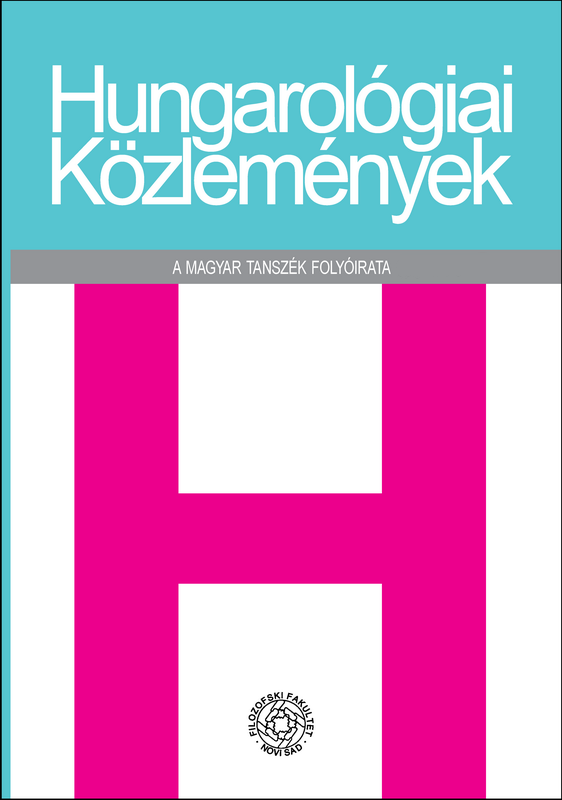A SZIGETI VESZEDELEM JELZŐRENDSZERE
Kulcsszavak:
funkcionális stilisztika, nyelvi elemzés, jelző, Zrínyi Miklós, Szigeti veszedelem
Absztrakt
A jelzők Zrínyi eposzának egyik kiemelkedő stíluseszközét képezik. A dolgozat a minősítő jelzős szerkezeteket szófaji és szerkezeti aspektusból vizsgálja. A jelzők szófaját tekintve
– a nagyszámú melléknévi jelző mellett – a főnévi jelzők rendkívül erőteljesek, tömörítő jellegűek, ugyanakkor a melléknévi igenévi jelzők is különleges stílushatásúak; mindhárom fajtájuk előfordul a korpuszban. Szerkezeti szempontból egyszerű (egy jelzőt tartalmazó) többszörös és halmozott jelzők különböztethetők meg az eposzban. Ez utóbbi típus eseté- ben a szerkezet jelzői lehetnek mellérendeltek, ezek szemantikailag erősítik egymást, de a jelzősor tagjai egymásba is fonódhatnak, ekkor fokozó jellegűek. Vannak olyan jelzők a szövegben, amelyek díszítőelemként vagy a prózaritmus, illetve a rímképlet kedvéért kerültek be, s gyakran ismétlődnek: ezek egyféle állandó jelzőként szerepelnek a műben, kialakítva ezáltal a tipikusan „zrínyies” jelzőket. Különleges hangulat és stílusfunkció tulajdonítható a szinesztéziás és metaforikus jelzők eposzbeli előfordulásának is. Az elemzésben a jelzők stilisztikai szerepének a vizsgálata mellett a jelentéstörténeti szempontok is helyet kaptak, valamint a képszerűség, a metaforikusság és a jelzők kontextuális kérdései – így például a hasonlatokba beépített jelzős szerkezetek – is felmerültek.Hivatkozások
Balogh Judit. 2000a. A főnév. In Magyar grammatika, szerk Keszler Borbála. 127–141. Budapest: Nemzeti Tankönyvkiadó.
Balogh Judit. 2000b. A jelző és az értelmező. In Magyar grammatika, szerk. Keszler Borbála. 444–460. Budapest: Nemzeti Tankönyvkiadó.
Beke József szerk. 2004. Zrínyi-szótár . Zrínyi Miklós életművének magyar szókészlete. Budapest: Argumentum.
Benkő Loránd főszerk. 1964–1984. A magyar nyelv történeti–etimológiai szótára . I–IV. Budapest: Akadémiai Kiadó.
Benkő Loránd főszerk. 1995. A magyar nyelv történeti nyelvtana. II/2 . A kései ómagyar kor . Mondattan . Szöveggrammatika. Budapest: Akadémiai Kiadó.
Berrár Jolán. 1957. Történeti mondattan. Budapest: Tankönyvkiadó.
Di Francesco, Amedeo. 1979. Kőszikla és forgószél: jelképek a Szigeti veszedelemben. MTA Nyelv- és Irodalomtudományok Osztályának Közleményei 31 (3–4): 293–308.
Fábián Pál–Szathmári István–Terestyéni Ferenc. 1977. A magyar stilisztika vázlata. Budapest: Tankönyvkiadó.
S. Hámori Antónia. 1995. A jelzős szerkezetek. In A magyar nyelv történeti nyelvta- na . II/2 . A kései ómagyar kor . Mondattan . Szöveggrammatika . 329–425. Budapest: Akadémiai Kiadó.
Kemény Gábor. 2002. Bevezetés a nyelvi kép stilisztikájába. Budapest: Tinta Könyvkiadó. Keszler Borbála szerk. 2000. Magyar grammatika. Budapest: Nemzeti Tankönyvkiadó.
Rajsli Ilona. 2013. A szinesztéziás jelzők fejlődéstörténetéből. In Diakrón nyelvi metsze- tek . Nyelvtörténeti tanulmányok . 103–109. Újvidék: Bölcsészettudományi Kar– Vajdasági Felsőoktatási Kollégium.
Szathmári István. 2004. Stilisztikai lexikon. Budapest: Tinta Könyvkiadó.
Szikszainé Nagy Irma. 2007. Magyar stilisztika. Budapest: Osiris Kiadó.
Zrínyi Miklós. 1980. Adriai tengernek Syrenaia. Hasonmás kiadás. Utószó Kovács Sándor Iván. Budapest: Akadémiai Kiadó–Magyar Helikon
Balogh Judit. 2000b. A jelző és az értelmező. In Magyar grammatika, szerk. Keszler Borbála. 444–460. Budapest: Nemzeti Tankönyvkiadó.
Beke József szerk. 2004. Zrínyi-szótár . Zrínyi Miklós életművének magyar szókészlete. Budapest: Argumentum.
Benkő Loránd főszerk. 1964–1984. A magyar nyelv történeti–etimológiai szótára . I–IV. Budapest: Akadémiai Kiadó.
Benkő Loránd főszerk. 1995. A magyar nyelv történeti nyelvtana. II/2 . A kései ómagyar kor . Mondattan . Szöveggrammatika. Budapest: Akadémiai Kiadó.
Berrár Jolán. 1957. Történeti mondattan. Budapest: Tankönyvkiadó.
Di Francesco, Amedeo. 1979. Kőszikla és forgószél: jelképek a Szigeti veszedelemben. MTA Nyelv- és Irodalomtudományok Osztályának Közleményei 31 (3–4): 293–308.
Fábián Pál–Szathmári István–Terestyéni Ferenc. 1977. A magyar stilisztika vázlata. Budapest: Tankönyvkiadó.
S. Hámori Antónia. 1995. A jelzős szerkezetek. In A magyar nyelv történeti nyelvta- na . II/2 . A kései ómagyar kor . Mondattan . Szöveggrammatika . 329–425. Budapest: Akadémiai Kiadó.
Kemény Gábor. 2002. Bevezetés a nyelvi kép stilisztikájába. Budapest: Tinta Könyvkiadó. Keszler Borbála szerk. 2000. Magyar grammatika. Budapest: Nemzeti Tankönyvkiadó.
Rajsli Ilona. 2013. A szinesztéziás jelzők fejlődéstörténetéből. In Diakrón nyelvi metsze- tek . Nyelvtörténeti tanulmányok . 103–109. Újvidék: Bölcsészettudományi Kar– Vajdasági Felsőoktatási Kollégium.
Szathmári István. 2004. Stilisztikai lexikon. Budapest: Tinta Könyvkiadó.
Szikszainé Nagy Irma. 2007. Magyar stilisztika. Budapest: Osiris Kiadó.
Zrínyi Miklós. 1980. Adriai tengernek Syrenaia. Hasonmás kiadás. Utószó Kovács Sándor Iván. Budapest: Akadémiai Kiadó–Magyar Helikon








